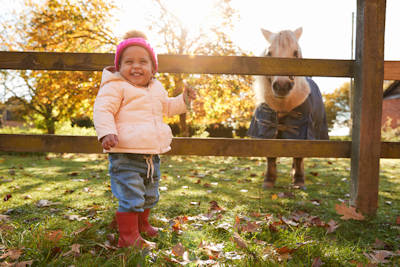Horseback Riding Tips for Toddlers
** Affiliate disclosure. This web site is supported by its awesome audience. When you click or purchase through links on our site, we may earn an affiliate commission.

A few things you should know before you take your toddler horseback riding. These things include Safety rules, Age limits, and breeds. Read on to learn more! Also read: How to get started. This article will give you a brief rundown of some important rules for horseback riding toddlers. And make sure to read the FAQs to make sure that you get the best experience possible! Here are some great tips to help your little one get started.
Safety rules
If you want to introduce your toddler to the world of horseback riding, follow some important safety rules. You should keep the lead rope out of your child’s fingers and never lead a horse by hand. Never let your child tie the horse’s lead rope by putting their hand in the halter. The horse can startle and injure your child if you try this! Children should always follow the basic safety rules of handling horses, such as never kneeling the horse. Instead, they should stay squatting or on their feet.
First, your child should wear a helmet. This should fit properly and be ASTM certified. You can purchase one or rent one from the stables or camp you’re attending. It’s also important to remember that horseback riding is not a chore or something your child must do. Forcing them to participate will make it less fun and they won’t enjoy it as much. Also, the safety rules will help your child learn proper horseback riding techniques.
Children should never run up to a horse that they don’t know. Unlike dogs, horses have a range of personalities and should never be approached by an untrusting child. Always ask the owner’s permission first. A horse may be friendly, but it’s best to wait for them to be ready to respond to any questions or requests. Also, make sure that the horse is comfortable before your child gets on.
When approaching a horse, it’s crucial for your child to know a few basic horse safety rules. You should never approach a horse from behind or stand in the horse’s blind spot. It’s easy for children to get caught in the horse’s blind spot, and this can result in a fatal kick. Similarly, children should always avoid going under the horse’s belly. Children are too small for the horse to see their backs and may get spooked if they do.
Aside from ensuring the safety of your child, you should also make sure that they understand the importance of supervision. During a riding experience, a child should wear the appropriate helmet and saddle for their age and height. You should also ensure that he or she wears the correct clothing and a harness. Always be aware of any other riders in the group. Remember to always keep a close eye on your child.
Breeds
When choosing a horse for your child’s first ride, it’s important to choose one that will be safe and develop their riding skills. While any horse can be safe for a child, certain breeds are especially suited to this age group. A pony is an excellent choice for a toddler, as it is easier to mount and less likely to injure your child in case of a fall. However, if your child is an experienced rider, you might want to choose a larger horse that will not be too intimidating for a young rider.
Arabian horses are often used as mounts for toddlers, and are known for their high-strung temperament. They are usually pinto-colored, but can be solid or spotted. They are fairly large, at around 14 to 15 hands. Although they are a bit expensive, they make excellent mounts for children. They also have plenty of muscle and are generally easygoing and calm, making them a good choice for a toddler.
Miniatures are small horses that are not registered, and can be good for learning how to groom and handle. Miniatures can also be shown and driven, and are great companions. Some even make therapy animals. In addition to being fun, miniatures are great for learning to ride, and can help children develop their confidence. They are also a good choice for toddlers who are learning the ropes of horseback riding.
There are several breeds of horses suitable for young riders. American Quarter Horses are the most popular and versatile horse breed in the United States. They excel in many disciplines and are easily available for toddlers. Since the breed is so common, they are easily accessible. Most Quarter Horses are also easy to find and have low maintenance requirements. They are the most common breed in the United States and can be found everywhere. It is also one of the most popular horses in the country, making it a convenient option for young riders.
Connemara Ponies are a great option for first-time riders and are versatile. Their low-maintenance nature makes them perfect for children with anxiety and fear of heights. They are also known for being gentle and sociable, making them a great choice for first-time riders. They are also a great choice for toddlers because they are low-maintenance, and are highly adaptable to different climates.
Age limit
Most equestrian centers have strict age limits for children who ride horses. Children under three are not considered old enough to ride on their own but can ride with a companion or a professional rider. In some cases, this restriction can be waived. However, it is still a good idea to keep the child at least a year away from riding horses. A horseback riding toddler class will teach a child basic safety practices.
When choosing an equestrian center, the first step is to research it. Ask questions to find out what services and activities are offered at different centers. Some centers may only teach adults, so be sure to ask questions. If your child can’t control their emotions, you might want to wait until they are older. If you don’t know a trainer, you can check online to find out if they teach children.
Kids don’t focus on a single activity for more than 15 minutes. It is possible to get them to sit and ride the horse for ten to twenty minutes, but after that, they’ll get bored and want to try something else. Therefore, it’s best to limit the time your toddler spends on horseback riding. For best results, enroll your child in an equestrian center, or hire a riding instructor.
While some riding centers set an age limit of around nine years, some are willing to work with children as young as six. During the initial lessons, children will learn the basics of saddling, grooming, bridling, and tying a riding helmet. However, they should always speak in a calm manner and make sure that they are not bumping into a horse’s rear end.
There are many reasons why it is important for a child to be at least three years old before they can start riding a horse. First and foremost, they need to have some degree of muscle memory and coordination. Secondly, the horse’s walking motion is unlike anything they have ever done before, so they don’t have the same muscle memory as adults. As a result, a three-year-old may struggle to balance properly on the horse. And lastly, children are still developing their attention spans.
Getting started
Getting started horseback riding with toddlers requires several preparations. While young kids might be eager to try out the sport, they may not be emotionally prepared for it. Horses need humans to keep them calm. Shouting or yelling can make the animals react in dangerous ways. If your child is not yet emotionally and physically ready for riding, you should wait until they are. Here are some tips to help you get started with horseback riding with toddlers.
It’s important to note that toddlers’ attention spans are different from those of adults. If you’re planning to take your toddler to a horseback riding lesson, make sure to allow plenty of time to allow your child to do as much riding as she wants. Similarly, if your child asks to ride for an hour straight, let her do so. The key is to recognize that some children pick up the skills faster than others and may have more natural athletic abilities.
The most common mistake parents make is making the child stand in one position for too long. This can be dangerous for a child and should be avoided at all costs. If your child does not execute the stretches correctly, he or she will rock forward and off the seat bones. If your child needs help mounting and dismounting, hold his or her lower leg, hip, or bottom in the proper position. Then, make sure that your child doesn’t lean forward or extend her arms to stand. Trying to force your child into horseback riding is not likely to be fun and will likely make your child less interested in learning.
In addition to promoting healthy physical and emotional growth, horseback riding helps kids develop valuable social skills, including cooperation, friendship, and responsibility. Riding with horses can be a rewarding experience and foster a lifelong passion for the animal. You can even help them learn new skills while they’re at it. The benefits of getting started horseback riding with toddlers are numerous. And if you’re in the market for a beginner horseback riding experience, there are plenty of summer camps in your area with reliable horses and affordable group instruction.

Sarah is the lead content developer at HorseKids.com She also writes in the pet and wellness space. On HorseKids.com Sarah specializes in covering the top products for horse lovers and DIY tips and articles.